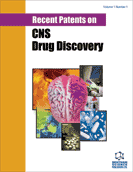Abstract
G protein-coupled receptors (GPCRs) are the largest class of cell surface receptors in humans. They convey extracellular signals into the cell interior by activating intracellular processes such as heterotrimeric G protein-dependent signaling pathways. They are widely distributed in the nervous system, and mediate key physiological processes including cognition, mood, appetite, pain and synaptic transmission. With at least 30% of marketed drugs being GPCR modulators, they are a major therapeutic target in the pharmaceutical industrys drug discovery programs. This review will survey recently patented ligands for GPCRs implicated in CNS disorders, in particular the metabotropic glutamate, adenosine and cannabinoid receptors. Metabotropic glutamate receptors regulate signaling by glutamate, the major excitatory brain neurotransmitter, while adenosine is a ubiquitous neuromodulater mediating diverse physiological effects. Recent patents for ligands of these receptors include mGluR5 antagonists and adenosine A1 receptor agonists. Cannabinoid receptors remain one of the most important GPCR drug discovery target due to the intense interest in CB1 receptor antagonists for treating obesity and metabolic syndrome. Such small molecule ligands are the outcome of the continuing focus of many pharmaceutical companies to identify novel GPCR agonist, antagonist or allosteric modulators useful for CNS disorders, for which more effective drugs are eagerly awaited.
Keywords: G protein, receptor, signaling, drug target, drug discovery, ligand, agonist, antagonist, metabotropic glutamate, adenosine
 9
9

